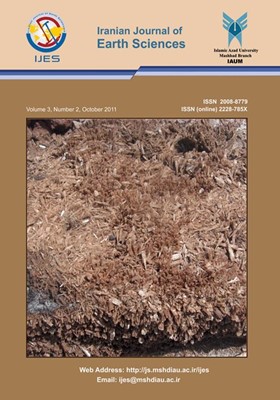Role of Mineralogy and Geochemistry in the Beneficiation of Jajarm Bauxite from North East Iran: Comparison with some other Bauxite Deposits of the World
محورهای موضوعی : Mineralogy
1 - Department of Geology, Faculty of Sciences, Mashhad Branch, Islamic Azad University, Mashhad, Iran.
کلید واژه: Iran, Mineralogy, Bauxite Deposit, Bauxite mineralogy, Beneficiation, Jajarm,
چکیده مقاله :
Two types of bauxite occur in the Jajarm Bauxite deposit, the first one is the hard bauxite and the other is the shaly bauxite or soft bauxite. The Al 2 O 3 content ranges from 30% to 60% and SiO 2 varies between 5% to 39%.The total tonnage is more than 22 million tons with a mean value of Al 2 O 3 content between 47% to 48% , SiO 2 around 10% and Fe 2 O 3 ranges between 6.95 to 27% . The Jajarm bauxite deposit shows high concentration of active SiO 2 and Fe 2 O 3 in comparison with other bauxite deposits of the world. Efforts have been made in this research to delineate the characteristics of the Jajarm monohydrate bauxites, consisting of a diaspore and chamosite mixture, to improve their chemistry by different beneficiation techniques and optimize their processing, grinding and digestion conditions for alumina production The Jajarm bauxite shows politomorphic and micro- granular texture with several secondary textural elements. The size of diaspore grains (which is the main mineral component) are generally below 10 microns, with a homogeneous matrix. In addition, for the very hard bauxite we can not do any separation between the crystal grains and the matrix because of similar hardness for both with closely packed space filling and in consequence of the absence of well- defined grain boundaries. Based on the above studies, the Jajarm bauxite can be enriched neither by grain analysis nor by magnetic separation. In this research hard bauxite was crushed between 2 to 3 inches and then samples were washed with 5% HCl. The result of this laboratory studies shows that the silica modulus has improved from 1.05 to 2.56 which indicates an increase of 29% in the Al 2 O 3 content. Jajarm laboratory s study shows that Jajarm bauxite deposit partially can be improved only by water treatment.
Two types of bauxite occur in the Jajarm Bauxite deposit, the first one is the hard bauxite and the other is the shaly bauxite or soft bauxite. The Al 2 O 3 content ranges from 30% to 60% and SiO 2 varies between 5% to 39%.The total tonnage is more than 22 million tons with a mean value of Al 2 O 3 content between 47% to 48% , SiO 2 around 10% and Fe 2 O 3 ranges between 6.95 to 27% . The Jajarm bauxite deposit shows high concentration of active SiO 2 and Fe 2 O 3 in comparison with other bauxite deposits of the world. Efforts have been made in this research to delineate the characteristics of the Jajarm monohydrate bauxites, consisting of a diaspore and chamosite mixture, to improve their chemistry by different beneficiation techniques and optimize their processing, grinding and digestion conditions for alumina production The Jajarm bauxite shows politomorphic and micro- granular texture with several secondary textural elements. The size of diaspore grains (which is the main mineral component) are generally below 10 microns, with a homogeneous matrix. In addition, for the very hard bauxite we can not do any separation between the crystal grains and the matrix because of similar hardness for both with closely packed space filling and in consequence of the absence of well- defined grain boundaries. Based on the above studies, the Jajarm bauxite can be enriched neither by grain analysis nor by magnetic separation. In this research hard bauxite was crushed between 2 to 3 inches and then samples were washed with 5% HCl. The result of this laboratory studies shows that the silica modulus has improved from 1.05 to 2.56 which indicates an increase of 29% in the Al 2 O 3 content. Jajarm laboratory s study shows that Jajarm bauxite deposit partially can be improved only by water treatment.


